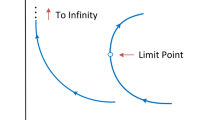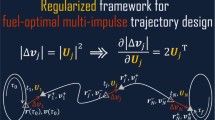Abstract
Solving minimum-time low-thrust orbital transfer problems in the three-body problem by indirect methods is an extremely difficult task, which is mainly due to the small convergence domain of the optimal solution and the highly nonlinear nature associated with the three-body problem. Homotopy methods, the principle of which is to embed a given problem into a family of problems parameterized by a homotopic parameter, have been utilized to address this difficulty. However, it is not guaranteed that the optimal solution of the original problem can be obtained by most of the existing homotopy methods. In this paper, a new bounding homotopy method is proposed, by which the continuous homotopy path can be constructed and the optimal solution of the original problem is guaranteed to be found. In the parameter bounding homotopy method, an initialized problem with much higher thrust is constructed and a state-of-the-art parameter bounding homotopy approach is utilized to connect separated homotopy branches outside the predefined domain of the homotopic parameter. Furthermore, multiple optimal solutions of the original problem can be obtained if the homotopic approach continues after the first solution, among which the best solution can be figured out. Finally, numerical solutions of minimum-time low-thrust orbital transfers from GEO to Moon orbit and from GTO to halo orbit in the circular restricted three-body problem are provided to demonstrate the effectiveness of the homotopy method.



















Similar content being viewed by others
References
Rayman, M. D., Varghese, P., Lehman, D. H., Livesay, L. L.: Results from the Deep Space 1 technology validation mission. Acta Astronaut. 47(2), 475–487 (2000)
Kawaguchi, J., Fujiwara, A., Uesugi, T. K.: The ion engines cruise operation and the Earth swingby of ‘Hayabusa’(MUSES-C). In: 55th International Astronautical Congress, IAC Paper, pp 4–8 (2004)
Kugelberg, J., Bodin, P., Persson, S., Rathsman, P.: Accommodating electric propulsion on SMART-1. Acta Astronaut. 55(2), 121–130 (2004)
Benkhoff, J., Casteren, J. V., Hayakawa, H., Fujimoto, M., Laakso, H., Novara, M., Ferri, P., Middleton, H. R., Ziethe, R.: BepiColombo-comprehensive exploration of Mercury: Mission overview and science goals. Planetary & Space Science 58(1), 2–20 (2010)
Li, S., Zhu, Y., Wang, Y.: Rapid design and optimization of low-thrust rendezvous/interception trajectory for asteroid deflection missions. Adv. Space Res. 53(4), 696–707 (2014)
Taheri, E., Abdelkhalik, O.: Initial three-dimensional low-thrust trajectory design. Adv. Space Res. 57(3), 889–903 (2016)
Oshima, K., Campagnola, S., Yanao, T.: Global search for low-thrust transfers to the Moon in the planar circular restricted three-body problem. Celestial Mechanics & Dynamical Astronomy 128(2-3), 303–322 (2017)
Kluever, C. A.: Optimal Earth-Moon trajectories using combined chemical-electric propulsion. J Guid Control Dyn 20(2), 253–258 (1997)
Betts, J. T., Erb, S. O.: Optimal low thrust trajectories to the Moon. Siam Journal on Applied Dynamical Systems 516(2), 144–170 (2003)
Herman, A. L., Conway, B. A.: Optimal, low-thrust, Earth-Moon orbit transfer. J Guid Control Dyn 21(1), 141–147 (1996)
Park, C., Gong, Q., Ross, I., Sekhavat, P.: Fuel-optimal design of Moon-Earth trajectories using legendre pseudospectral method. In: AIAA/AAS Astrodynamics Specialist Conference and Exhibit (2008)
Yan, H., Wu, H.: Optimal low-thrust Earth-Moon targeting strategy for n-body problem. J Guid Control Dyn 24(3), 626–628 (2001)
Mingotti, G., Topputo, F., Bernellizazzera, F.: Optimal low-thrust invariant manifold trajectories via attainable sets. J Guid Control Dyn 34(6), 1644–1656 (2011)
Bryson, A. E., Ho, Y. C.: Applied optimal control. Hemosphere, Washington D.C. (1975)
Pontryagin, L.S.: Mathematical Theory of Optimal Processes. CRC Press, Boca Raton (1987)
Taheri, E., Li, N. I., Kolmanovsky, I.: Co-state initialization for the minimum-time low-thrust trajectory optimization. Adv. Space Res. 59(9), 2360–2373 (2017)
Guo, C., Zhang, J., Luo, Y., Yang, L.: Phase-matching homotopic method for indirect optimization of long-duration low-thrust trajectories. Adv. Space Res. 62(3), 568–579 (2018)
Kluever, C. A., Pierson, B. L.: Optimal low-thrust three-dimensional Earth-moon trajectories. J Guid Control Dyn 18(4), 830–837 (1995)
Kluever, C. A., Pierson, B. L.: Optimal Earth-Moon trajectories using nuclear electric propulsion. J Guid Control Dyn 20(2), 239–245 (1997)
Gao, Y.: Earth-moon trajectory optimization using solar electric propulsion. Chin. J. Aeronaut. 20(5), 452–463 (2007)
Russell, R. P.: Primer vector theory applied to global low-thrust trade studies. J Guid Control Dyn 30(2), 460–472 (2007)
Howell, K. C., Ozimek, M. T.: Low-Thrust transfers in the Earth-Moon system, including applications to libration point orbits. J Guid Control Dyn 33(2), 533–549 (2008)
Lee, D., Bang, H., Kim, H. D.: Optimal Earth-Moon trajectory design using new initial costate estimation method. J Guid Control Dyn 35(5), 1671–1676 (2012)
Watson, L. T.: Probability-one homotopies in computational science. Journal of Computational & Applied Mathematics 140(1), 785–807 (2002)
Guo, T., Fanghua, J., Junfeng, L.: Homotopic approach and pseudospectral method applied jointly to low thrust trajectory optimization. Acta Astronaut. 71 (2012), 38–50 (2012)
Pan, B., Lu, P., Pan, X., Ma, Y.: Double-homotopy method for solving optimal control problems. J Guid Control Dyn 39(8), 1–15 (2016)
Bertrand, R., Epenoy, R.: New smoothing techniques for solving bang-bang optimal control problems-numerical results and statistical interpretation. Optimal Control Applications & Methods 23(4), 171–197 (2002)
Caillau, J. B., Daoud, B.: Minimum time control of the restricted three-body problem. SIAM J. Control. Optim. 50(6), 3178–3202 (2012)
Caillau, J. B., Farrés, A: On Local Optima In Minimum Time Control of the Restricted Three-Body Problem, pp 209–302. Springer International Publishing, Cham (2016)
Caillau, J. B., Daoud, B., Gergaud, J.: Minimum fuel control of the planar circular restricted three-body problem. Celest. Mech. Dyn. Astron. 114(1), 137–150 (2012)
Zhang, C., Topputo, F., Bernelli-Zazzera, F., Zhao, Y. S.: Low-thrust minimum-fuel optimization in the circular restricted three-body problem. J Guid Control Dyn 38(8), 1501–1509 (2015)
Tang, G., Jiang, F.: Capture of near-Earth objects with low-thrust propulsion and invariant manifolds. Astrophysics & Space Science 361(10), 9–22 (2016)
Pèrez-Palau, D., Epenoy, R.: Fuel optimization for low-thrust Earth-Moon transfer via indirect optimal control. Celest. Mech. Dyn. Astron. 130(2), 21 (2018)
Malinen, I., Tanskanen, J.: Homotopy parameter bounding in increasing the robustness of homotopy continuation methods in multiplicity studies. Computers & Chemical Engineering 34(11), 1761–1774 (2010)
Pan, B., Pan, X., Lu, P.: Finding best solution in low-thrust trajectory optimization by two-phase homotopy. Journal of Spacecrafts & Rockets 56(1), 283–291 (2019)
Caillau, J. B., Gergaud, J., Noailles, J.: 3D geosynchronous transfer of a satelite: continuation on the thrust. J. Optim. Theory Appl. 118(3), 541–565 (2003)
Gergaud, J., Haberkorn, T.: Homotopy method for minimum consumption orbit transfer problem. Esaim Control Optimisation & Calculus of Variations 12(2), 294–310 (2006)
Jiang, F., Baoyin, H., Li, J.: Practical techniques for low-thrust trajectory optimization with homotopic approach. J Guid Control Dyn 35(1), 245–258 (2012)
Chen, Z.: Optimality conditions applied to free-time multi-burn optimal orbital transfers. J Guid Control Dyn 39(11), 2512–2521 (2016)
Taheri, E., Kolmanovsky, I., Atkins, E.: Enhanced smoothing technique for indirect optimization of minimum-fuel low-thrust trajectories. J Guid Control Dyn 39(11), 2500–2511 (2016)
Chi, Z., Yang, H., Chen, S., Li, J.: Homotopy method for optimization of variable-specific-impulse low-thrust trajectories. Astrophysics & Space Science 362 (11), 216 (2017)
Zhao, S., Zhang, J., Xiang, K., Qi, R.: Target sequence optimization for multiple debris rendezvous using low thrust based on characteristics of SSO. Astrodynamics 1(1), 85–99 (2017)
Pan, B., Pan, X., Ma, Y.: A quadratic homotopy method for fuel-optimal low-thrust trajectory design. Proceedings of the Institution of Mechanical Engineers Part G Journal of Aerospace Engineering 232(5), 1741–1757 (2019)
Paloschi, J. R.: Bounded homotopies to solve systems of algebraic nonlinear equations. Computers & Chemical Engineering 19(12), 1243–1254 (1995)
Acknowledgments
The authors gratefully acknowledge the support to this work by the National Natural Science Foundation of China (Grant No. 11672234).
Author information
Authors and Affiliations
Corresponding author
Ethics declarations
Conflict of interests
On behalf of all authors, the corresponding author states that there is no conflict of interest.
Additional information
Publisher’s Note
Springer Nature remains neutral with regard to jurisdictional claims in published maps and institutional affiliations.
Rights and permissions
About this article
Cite this article
Pan, X., Pan, B. & Li, Z. Bounding Homotopy Method for Minimum-Time Low-Thrust Transfer in the Circular Restricted Three-Body Problem. J Astronaut Sci 67, 1220–1248 (2020). https://doi.org/10.1007/s40295-020-00213-4
Published:
Issue Date:
DOI: https://doi.org/10.1007/s40295-020-00213-4




